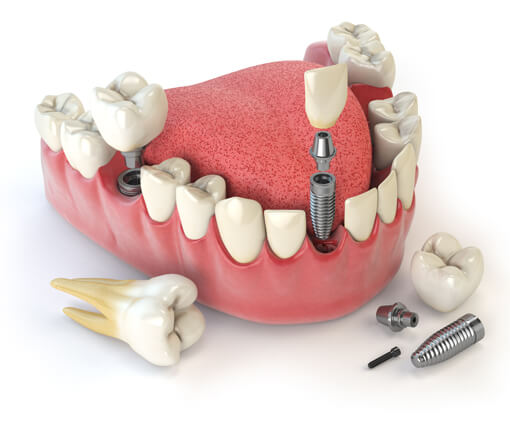Contents
- 1 What is periodontal disease? Treatment and prevention
- 2 What is periodontal disease?
- 3 2. Causes of periodontal disease
- 4 Signs of periodontal disease
- 5 What to do when detecting periodontal disease?
- 6 How to prevent periodontal disease
- 7 Proper oral hygiene to prevent periodontal disease
- 8 Home Dental – A reputable dental clinic for periodontal disease treatment
What is periodontal disease? Treatment and prevention
Periodontal disease is a common oral disease. This is also the main cause of mass tooth loss. So what is periodontal disease? What are the signs of the disease?
What is periodontal disease?
The periodontium is the organization around the teeth that supports and holds the teeth in the jawbone. Healthy teeth are held in the jawbone by alveolar bone, ligaments, and gums. Gums that hug the teeth help protect the sensitive tissue underneath and prevent bacteria from entering and damaging the teeth.
In fact, periodontal disease is a disease of the tissues around the teeth. It is the main cause of tooth loss, which can affect patients’ health and aesthetics of the teeth. The consequences of periodontitis are particularly serious, requiring early diagnosis and treatment.

2. Causes of periodontal disease
The main cause of periodontitis is bacteria. They cause inflammation on the periodontal tissues, and can even cause you to lose teeth if not treated promptly. There are a number of reasons why bacteria can cause periodontitis, such as:
- Infrequent dental hygiene
- Smoke
- Leftover food stuck between teeth is not cleaned
- The structure of the teeth is not tight
- Pregnant women are more prone to periodontitis than the general population.
- Poor immune system.
- Besides, hormonal changes can also lead to swollen gums, gingivitis. If inflammation is prolonged, it can lead to superinfection of bacteria and makes the disease difficult to stop.
Signs of periodontal disease
Periodontal disease can be divided into two main categories, which are gingivitis and periodontitis. Gingivitis can be considered as an early stage when the gums have not yet developed into periodontitis.
Gingivitis usually appears when we enter puberty. As for periodontitis, it often occurs in teenagers or older people. Periodontitis often happens due to lack of careful care and treatment when people have gingivitis. As a result, complications began to occur and gingivitis will develop into periodontitis.
Stages of periodontitis
In the early stages, periodontitis develops silently, the patient has almost no symptoms and does not even feel any pain. But if the disease is at a severe stage, it will cause some uncomfortable symptoms and possibly become a chronic disease.
Stage 1
In the oral cavity, tartar will form. This is because oral hygiene is not guaranteed. As a result, these bacteria are facilitated to enter the oral cavity. They accumulate and stick to places such as between teeth, gum line, neck of teeth, etc, causing irritation to the gums causing inflammation.
Stage 2
More serious gingivitis. The gums swell and bleed. In particular, when patients chew food or brush their teeth, this phenomenon is more pronounced.
Stage 3
This stage is a sign that gingivitis has not been properly treated before. This leads to the formation of pus-filled bacteria in the gums.
Stage 4
Once periodontal disease has formed, they will begin to destroy the alveolar bone. Over time, severe inflammation and gum recession will appear. And when the organization around the teeth is no longer secure, the teeth will gradually loosen. More dangerous, there will be the risk of tooth loss.
Signs to recognize periodontal disease
Patients with periodontal disease often experience symptoms such as:
- Red swollen gums that are easy to bleed, especially when brushing teeth. In the heavy stage, if patients press on the gums, they can see pus.
- Presence of tartar in the neck of the tooth
- Feeling uncomfortable when eating.
- Bad breath.
- In the severe stage, teeth may be loose.
- Sparse teeth due to displacement
What to do when detecting periodontal disease?
When detecting periodontal disease, patients need to go to the hospital immediately for examination and timely treatment. In general, patients with periodontal disease usually experience one of the following four cases:
Emergency treatment
Emergency treatment of periodontal disease is applied when an abscess appears in the gum area and the mucosa is inflamed. When we touch the abscess, there will be signs of pain and the mucosa is red and swollen.
In this case, the doctor will usually prescribe appropriate antibiotics and anti-inflammatory drugs. However, this method is only temporary. The disease is still at risk of progressing to a chronic condition.
Non-surgical treatment
Non-surgical treatment will be applied depending on the condition of periodontal disease:
- Apply anti-inflammatory drugs and disinfect the site of inflammation.
- Remove tartar.
- Check the fillings again, consider correction or replacement.
- Fix loose teeth.
- In case it is not possible to save the tooth, the doctor will proceed to extract the tooth.
Surgical treatment
In case the above methods do not work, the patient will have to undergo surgery:
- Surgical removal of the periodontal pocket to easily clean the plaque on the teeth.
- Surgical reconstruction of periodontal tissue and bone, preserving functions.
- Surgery to graft soft tissues, limit the situation of receding gums and restore the tissues around the teeth.
Maintenance treatment
The treatment of periodontal disease does not stop at the above methods. After treatment, the patient still needs to be monitored to ensure a stable condition. Patients need to have regular dental visits and appropriate care regimens. This is to avoid recurrence and progression of the disease.
How to prevent periodontal disease
Proper oral hygiene to prevent periodontal disease
Regular and proper oral hygiene is not only the most effective preventive measure against periodontitis, but also prevents many oral diseases. In fact, brushing your teeth after each meal is extremely important because it helps to remove bacteria on dental plaque, and cleans tartar on the surface of the teeth secreted by bacteria.
Dentists recommend that you brush your teeth regularly from 2 to 3 times a day and have to do the right brushing “technique”. After brushing your teeth, you should proceed to brush your tongue. This action is also very important because it eliminates bacteria that cause bad breath in the oral cavity.
Please note that for effective brushing, we need to choose a brush that is soft and fits your teeth. Do not use a brush that is too big because it will make teeth and gums hurt. In addition, it is also important to note that when the bristles are stiff and faded, it is also time to change to a new brush.
Rinse your mouth regularly with dilute salt water
After brushing your teeth, you should rinse your mouth with dilute salt water within 30 seconds. This is the best way to remove the remaining bacteria on the teeth, thoroughly clean the teeth, and repel periodontitis.
Create a habit of flossing
Dentists recommend that we should use dental floss to clean teeth after each meal. This is a long, thin, very soft and tough thread that can penetrate every corner of the tooth to remove plaque in a simple, gentle way.
Build a reasonable diet
Diet is also one of the major factors that affect teeth and gums. The habit of eating a lot of rice, starch and sweets is the cause of more dental diseases. Disease-causing bacteria in the oral cavity will convert sugar and starch in food into acids that erode tooth enamel, easily penetrating the structures inside the teeth.
In addition to limiting sweets, carbonated drinks, and starches, you need to add good vitamins to strengthen the body’s immunity against pathogenic bacteria.
You should supplement your body with vitamins found in vegetables, natural fruits of the citrus family, and grapefruit, which contain less sweeteners and provide more vitamin C, which is beneficial for health. Vitamin C helps fight inflammation, participates in the process of fighting pathogenic bacteria for the body, increasing resistance against disease, repelling periodontitis. In particular, absolutely say “no” to cigarettes.
Periodic check-up and dental check-ups to prevent periodontal disease
To prevent periodontal disease, we should have a dental check-up and dental cleaning (tartar removal) after every 6 months. Removing tartar will help you prevent periodontal disease, have clean, shiny, beautiful teeth, and at the same time be more confident in communication.
Therefore, visiting your doctor and having regular dental check-ups will help you detect periodontal disease early to get the best treatment. You absolutely should not let the disease be incubated for too long, leading to more severe disease. If not, the disease will be both difficult to treat, and also costly and time consuming.
Home Dental – A reputable dental clinic for periodontal disease treatment
Home Dental is the first and only dental clinic in Hanoi to meet the high standard of Germany for medical facilities. Home Dental has a team of highly skilled and highly trained medical professionals. All the doctors at Home Dental have many years of experience and are trusted and appreciated by customers.
In addition, the clinic also has the system of modern clinic equipment that ensures absolute safety and sterility. The equipment system of Home Dental is imported directly from Germany. The clinic constantly updates the equipment system so that customers can benefit from dental treatment with advanced and modern equipment.
Home Dental commits to always give patients the best treatment results at a reasonable cost. Coming to Home Dental, patients can experience highly qualified service and will be completely satisfied.















